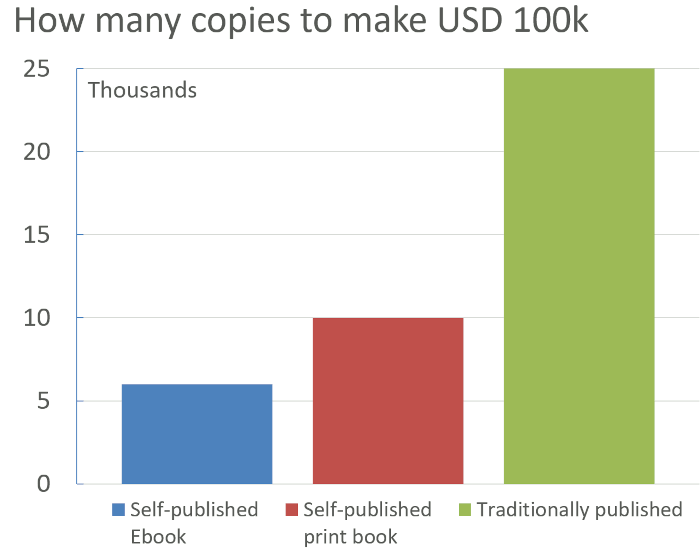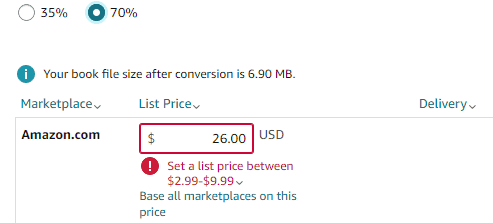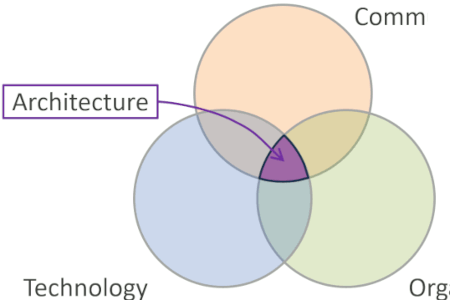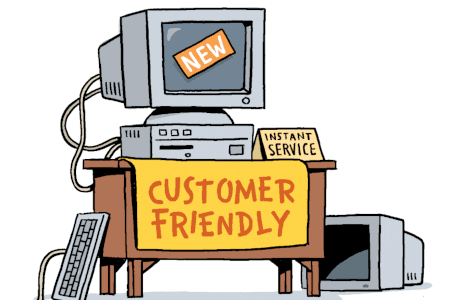Updated: Category: Strategy
Recently, a longtime friend and fellow author pointed out that he earns about $1/h from being a series editor for a major publisher. Apparently, some authors were surprised that the series editor doesn’t work for free.
Authors might be higher on the idealist spectrum when it comes to compensation, but there’s a healthy ground rule for technical authors, speakers, and series editors (see also this insightful Tweet):
Rule #0: If someone else makes money in the arrangement, so should you.
Architects prefer transparency. So, with money being mostly a whisper-whisper topic, I decided to shed some light on how much money you can earn from writing technical books. I’ll also discuss what publishing options you have and how they affect your payout.
Writing Books for Money
Before we even get into details, let me share the fundamental rule of writing technical books:
Rule #1: Never write a technical book for the money.
That doesn’t mean that you can’t make decent money from technical books. So, read on.
Making Money
Passive Income
Royalties are generally considered passive income (Investopedia), meaning you are not actively working on generating that income at the time you receive it (that doesn’t mean you just kick back, as we will soon see). Rental property or investment income are common examples (tax authorities have their own definition as the classification may impact taxation, especially the handling of losses).
In social media (especially in the US), passive income appears to be equated to free money, which obviously isn’t the case:
The “I retired with 30” stories usually translate into “I spend 24h a day creating content and managing my social media campaigns”.
In a way, passive income is delayed income: you earn for past work or for investments you made from the earnings from past work.
For books, the magic of deferred earnings lies in the fact that by the time the royalty check comes, the pain of writing is largely forgotten.
The satisfaction of seeing book sales come in while (mostly) sitting back is undeniable.

Some platforms like Leanpub even send you an e-mail for each sale—the happiest spam ever.
Can you make 100k?
Even though we should not write technical books for the money, as long as we don’t intend to give them away, we are keen to know how much money can be had. Another warning upfront:
Authors are those people who consider $500 a lot of money.
You can easily make more than $500 from a book, but when they receive a monthly royalty check over $500, many authors are quite excited. But let’s talk real money, perhaps not “boat money” but “decent car money”. What does it take to make USD $100,000 from a book?
Intuitively, the number of copies you need to sell depends on the royalty you receive per copy, which—as we will soon see—depends significantly on your distribution scheme.

The numbers are not entirely outlandish:
- 100k = 6k self-published EBooks ($20 retail, $16 royalty)
- 100k = 10k self-published print books ($30 retail, $10 royalty)
- 100k = 25k traditionally published books ($50 retail, $4 royalty)
So, if you have 50,000 social media followers, you just need to… BAAAP (the game show sound for wrong answer). Right answer: Conversion rates, meaning the percentage of people who see your book and then actually buy it. A 2-5% conversion rate on a website is already very good (on Amazon you may see a higher rate as people likely came there specifically to buy your book). So, if 100,000 people look at your book listing on Leanpub, and your targeting is good, 3,000 may buy it. That’s not too bad—half-way there.
Reality Check
So, how many copies does a technical book sell? Let’s start with some well-known books (these are ballpark numbers from chatting with publishers and fellow authors; if I have sources, they are linked below):
- Enterprise Integration Patterns (2003): 100k+
- Team Topologies (2019): 150k+
- UML Distilled (1997): 300k+ [Amazon]
- Design Patterns (1994): 500k+ [Wikipedia]
- The Unicorn Project (2018): 500k+ [Amazon]
You notice that these are all published through traditional channels. There’s not a simple “publishers sell more books” relationship here, as many established authors also have long-standing relationships and are less likely to self-publish. Still:
I don’t know of any self-published (technical) book that broke the 100,000 copy mark. Let me know if you do.
I heard from publishers that 10k copies sold is considered a success, and the publisher may ask you to write another one. According to this blog, 96% of books (mostly fiction) sell less than 5000 copies per year. For technical books, it may be worse.
How else can you get a feel for the number of copies sold? On Leanpub, many authors show the number of copies sold. For example, Simon Brown’s Software Architecture for Developers sold almost 27k copies as of May 2024. That can include giveaways, but is a very decent number in any case, as you may guess by it being #12 on the all-time bestseller list. Platform Strategy is at #19, which makes me rather happy.
Amazon does not reveal the number of copies sold, but you can use a little trick: the number of copies sold roughly follows the number of ratings on Amazon.com [US Marketplace]. I found that for recent books (let’s say the last 5 years), the following formula gives you a decent ballpark:
Copies sold = 60 x ratings on Amazon.com
That comes out pretty well for Team Topologies and The Software Architect Elevator. It’ll underestimate sales figures for older books (Design Patterns has roughly the same number of ratings as Team Topologies). Perhaps Amazon was smaller back then or fewer people left ratings. Also, different editions collect ratings separately, so you’d have to add those up.
Amazon may also display monthly sales for some titles, although that feature seems to come and go. It’ll indicate larger brackets like 100+ (for The Software Architect Elevator ), 250+ (for Kent Beck’s Tidy First or Sam Newman’s Building Microservices), 500+ (for Design Patterns), 1k+ (for the System Design Interview), or 2.5k+ (for Martin Kleppmann’s Designing Data-Intensive Applications). So, if the pace keeps up, Kent may sell around 5,000 copies per year on Amazon.
Longevity
As seen in the examples above, many high-selling books are “evergreens”, some of which have been around for one or two decades. Longevity a major factor for book revenue. However, that also means:
Rule #2: You may make 100k from your book, but don’t expect that to happen in 1 year!
Indeed, EIP made each author over $100k, but over the course of 20 years! So, think about the shelf life of the topic that you are keen to write about. EIP still sells a few thousand copies every year, 20 years after publication. Books about a specific technology may be obsolete after 12-18 months.

As you can see from my Amazon sales stats, 37 Things and Cloud Strategy had a solid 4-year run (Cloud Strategy shows in both turquoise for paperback and red for hard cover). 37 Things evolved into The Software Architect Elevator, so in total it has been doing well for 7+ years. One way to extend the life of your book is to publish 2nd and 3rd editions. If I ever find the time, a 2nd edition of Cloud Strategy would be timely 4 years after initial publication.
Revenue Split—Your Slice of the Pie
I mentioned that the amount that you will make per book varies by the distribution channel. Here is the rough percentage of the retail price (what the reader pays) flows into your pocket:
- Gumroad: 88% (2 % CC fee)
- Leanpub: 80%
- Amazon Kindle: (price < 10) ? 65% : 35%
- Amazon KDP: price * 60% - PrintCost
- Traditional publisher: 5-8%
Gumroad is often touted by the How I made a lot of money posts, some of which self-referentially describe the success of books that supposedly help you sell more copies (no links to those provided). Gumroad does pay you 90% minus the credit card fee, which runs 2-3%.
Most of my books start on Leanpub. That’s because Leanpub pays a very fair royalty rate (which includes credit card charges) and provides an entire book rendering system (more on that below). When you start out, you pay a monthly fee for additional features, but those are waived for established authors.
Kindle eBooks are special: the royalty share is very good for books under $10, but drops drastically to 35% for $10 and up, which applies to most technical books. This means that per copy you earn less than half compared to Leanpub.

Kindle Direct Publishing (KDP) allows you to self-publish print books on Amazon. The royalty share is fair at 60% (40% is a common retail margin for books, so a bookstore would pay the publisher about 60% of the regular retail price), but, unlike with traditional publishers, you pay for the print cost from your share. For a typical technical book with 300 pages, the math comes out roughly like this (print cost varies by marketplace):
Kindle Direct: $30 * 60% - $5 = $13
So, in the end you earn about 30-40% off the retail price, depending on the price you set.
Traditional publishers will pay around 15% of the net revenue, that is the money they get paid by the retailer (roughly 60%) minus print and shipping cost. That ends up being somewhere around 40% of the retail price, leaving you with roughly 6%, or $3 from a $50 book sale. That may seem low, but if the publisher moves 100k books without you doing any promotion, that’s not too shabby!
Naturally, if you have co-authors, your share shrinks proportionally (all authors share the same pie). Traditional publishers pay about 25% for audiobooks and eBook sales (thanks to low distribution cost), which means that those can easily make up half of your royalty check.
Making More Money
Selling books is not the only way to make money from books. Many authors I know are independent. The books are primarily a branding tool for them that helps attract business and allow for higher consulting rates. A single paid workshop can yield as much revenue as 1,000 copies sold. And, you can give books away at a workshop!
You might also be able to give paid talks, although speaking fees tend to vary widely and are often not taken for granted (see Rule #0). In my experience, you may be best off with paid on-line events like webinars because you don’t have travel time and expense to account for.
If you hold a full-time job, your options to generate additional revenue will be more limited. Some employers may restrict you from holding workshops, for example. Writing books is generally tolerated, but be sure to read the fine print.
Kief Morris has some great advice:
If you publish a book, you should be thinking about how it supports what you want to do with your career. If you want to get a “normal” job (like an engineering director role, CTO, etc.), a book might help you get an interview, but it won’t close the deal. As a consultant you’re selling your expertise and advice, which the book demonstrates.
Pricing
Your royalty rate is only half the equation, the other being the retail price. A traditional publisher will determine the price, typically around $40–$80 for technical books (yes, book prices are also subject to inflation). With self-published books you have control over pricing, but are also left with having to make a decision. I have little more than anecdotal advice and choose to price my books around $25-$30. That’s about half of what you’d pay for a technical book from a brand-name publisher. Given that the quality of self-published books is comparable to that of traditionally published ones, especially if you hire professional editing staff and illustrators, one may wonder whether a 100% “brand premium” is adequate. I actually believe Cloud Strategy is easily worth $50.
The minimum prices (Leanpub allows readers to adjust the price) of the best-selling Leanpub books (excluding ones with a minimum price of 0) are: $15 (SW Arch for Devs), $20 (Art of Data Science), $9.99 (Event Storming), so on the lower end of the spectrum. Still, you earn more on Leanpub for a $20 book than on Kindle for a $40 sale.
When my books start out on Leanpub, I set the initial price low ($9.99) to reward early readers, similar to Kickstarter. Those readers get all updates for free, but they do take a (small) risk that I never finish the book and are willing to read an unedited book. As the book matures, the price increases.
A useful pricing strategy that I haven’t explored yet are digital extras: offering the reader a workbook, template, toolkit, or video for an extra payment. It follows the well-proven advice that it’s much easier to get an existing buyer to spend $10 more than to find a brand-new buyer.
Reporting and Payout
So, you sold 100 books and started shopping for new gadgets? Not so fast! Virtually all channels have a hold period, either to account for returns (Leanpub has a 60-day money-back guarantee) or to avoid small payments, which accrue excessive fees.
| Gumroad | 7 days |
| Leanpub | 60 days |
| Amazon | 60 days |
| Publishers | 60-180 days |
Gumroad leads the pack here by paying you at the end of the week following the sale, meaning you wait 13 days in the worst case (plus a day or so for your bank to post the deposit). Leanpub holds your money until it’s sure that the book hasn’t been returned. Amazon pays on the same schedule, whereas traditional publishers can pay from monthly to bi-annually.
Leanpub gives you instant on-line reports, whereas publishers will send you a PDF with your payment. Amazon also provides on-line reports (broken down by day) with a slight delay.

Book Series
Book series are a vehicle for traditional publishers to place multiple titles into common branding to encourage cross-selling. Popular examples are Martin Fowler’s Signature Series with Pearson. Enterprise Integration Patterns is in that series, and that’s why it has an image of a bridge on the cover. Books that have similar titles like “Up and Running” by O’Reilly or “In Action” by Manning also look to sub-brand and cross-sell books, but are not series in this sense (they don’t have a series editor).
So, is the series author retiring off the series? Not quite. The usual share is 1% of the net revenue, so 20 cents off a $50 book sale. That money, to come back to the original argument, does not come from the author’s share. It is “on top” for the work of the series editor (who is more of a curator) and is funded by the assumption that series “carry” books, i.e. lead to higher sales figures.
If a series does well, meaning multiple books break the 50k or 100k mark, even the 1% still add up. Your series would have to move 500k copies to break the $100k barrier–a high bar. Very successful series can likely achieve this. But keep in mind: to become a series editor, you have to be a successful author first. Walk before you run.
One more piece of advice on book income:
Rule #3: Never calculate your book income per hour
Writing (and producing, promoting, etc.) a book takes thousands of hours, so spare yourself the misery of calculating an hourly wage.
Publishing: Self or Traditional
Revenue share isn’t the only consideration when selecting a publishing and distribution channel. You largely trade level of control against the amount of support you receive for production and marketing. Many first-time authors benefit from a traditional publisher, which brings credibility and positive brand image.
Here is my qualitative summary based on my experience:
| Gumroad | Leanpub | Amazon | Publisher | |
|---|---|---|---|---|
| Royalty Split | ++ | ++ | o | - |
| Tooling | None | PDF, EPUB | None | Full production |
| Control | ++ | ++ | o | - |
| Branding | - | - | - | ++ |
| Reach | o | o | + | ++ |
| Promotion | - | - | o | + |
We covered the revenue share, but the level of tooling you get varies. You have to bring a finished book to Gumroad and Amazon. For example, you could write in Asciidoc and render the book via Asciidoctor. Leanpub can render a PDF from your Markua script (a Markdown derivative optimized for books), or you can type in the browser. You are still on the hook for cover art, illustrations, copy editing, and layout. A traditional publisher will do all those for you. If you hire professionals for editing and artwork, expect to spend anywhere from $500 to a few thousand dollars depending on size and complexity of your work.
By outsourcing the work, you also lose a level of control. On Leanpub I can make content and pricing changes any time or create one-off coupons. On Amazon each change has a 72h wait period during which you can’t even order author copies. Once you are used to having full control, such a process feels tedious. Traditional publishers use a production pipeline, meaning your book gets slotted months ahead of time, and late changes are not welcome, unless you’re angling for a second edition.
In return publishers will give your branding power and will provide broader reach. If your goal is to reach the largest possible audience (as opposed to making the maximum profit), a traditional publisher is likely your best bet.
One more option for print books is to have your book printed and distributed by IngramSpark, one of world’s largest book printers and distributors. The advantage of this route is that your self-published book will be in bookstores and can be ordered by libraries, just like with a traditional publisher. They pay you 60% of the retail price minus print cost, which is the same as Kindle Direct (which is not pure coincidence). I have not used this option, but am tempted to try it.
Interestingly, “Expanded Distribution” in Kindle Direct makes your book available through Ingram, even though you published it on Amazon. Vice versa, if you publish with Ingram, your book will also be available on Amazon. Apparently, all print book roads seem to lead to these two behemoths.
Progressions
The nice thing is that the publishing channels aren’t entirely exclusive. My books usually begin with a series of blog posts (great for fast feedback), then progress to Leanpub, then to Kindle / KDP, and can then graduate to a traditional publisher. 37 Things went this route and evolved into The Software Architect Elevator.
It used to be that traditional publishers would not look at books that have already been self-published. That has changed dramatically: if your book does well on its own, the publisher figures that they can give it a significant boost. It actually presents a lower risk for the publisher.
Marketing, Advertising & Promotions
Leanpub will not bring you much traffic. You bring the traffic to Leanpub.
Rule #4: Self publishing is self marketing
Gumroad gets more traffic, but the rule pretty much applies (and getting more attention comes at a high cost). Amazon does bring you traffic—Amazon search rankings and recommendations have a big impact on sales. Traditional publishers can pay for listings, cross-link your book from other well-selling books, or send copies to influencers. Also, the publisher name builds trust and leads to higher conversions.
Many platforms include advertising schemes. Leanpub has The Shelf, Gumroad Discover boosts your listing for a minimum 30% cut off your sale. Amazon derives a non-trivial portion of its revenue from advertising (indicated by the “sponsored” label). It works much like Google ads where you pick keywords and bid for them. They are effective but expensive. A click can easily cost you $1. If you make $10 off a sale, a 20% conversion rate (which is quite good) will cut your profit in half as you’ll pay $5 in advertising fees to make one sale. So, you need to be certain that you would not have made the sale without the ad.
Potential buyers look at your description, the cover, and reviews. I found Goodreads reviews to be more trustworthy than Amazon reviews (Amazon owns Goodreads and shows both scores in some regions).
Other than paid ads, most authors promote their books through blogs, social media, and events. I personally love presenting at events, but found the resulting book sales to be rather anemic. If you fly to another country to present, you better have other ways to make it worth your time than the 5 or 10 books you may sell.
Coupons are a very useful promotional feature on Leanpub. Everyone loves a good deal, and although you may feel cheeky about it, a $20 book with a 25% discount coupon will outsell a $15 book with no discount. If you have never seen the haggling episode of the Life of Brian, now may be a good time to fill in that gap.
Getting Started
Naturally, before all this applies, you first need to write a book. I wish you best of luck and leave you with one last piece of advice:
How do you make $100k from a technical book? One sale at a time!
And how about the boat? Yes, I chartered this amazing yacht from my book money :-)
Grow Your Impact as an Architect

The Software Architect Elevator helps architects and IT professionals to take their role to the next level. By sharing the real-life journey of a chief architect, it shows how to influence organizations at the intersection of business and technology. Buy it on Amazon US, Amazon UK, Amazon Europe





